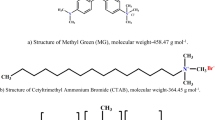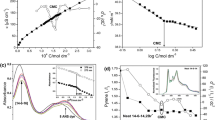Abstract
A homologous series of new gemini cationic surfactants were synthesized and characterized using micro elemental analysis, FTIR, 1H-NMR and mass spectra. The surface activities of these amphiphiles were determined based on the data of surface tension. Critical micelle concentration, effectiveness of the surface tension reduction, efficiency of adsorption, maximum surface excess, minimum surface area and critical packing parameter were evaluated. The effect of cationic micelles on solubilization of anionic azo dye, sulforhodamine B (Acid Red 52) in aqueous micellar solution of the synthesized gemini cationic surfactants was studied at pH 6.9 ± 0.5 and 25 °C. The results showed that the solubility of dye rose with increasing surfactant concentration as a consequence of some association between the dye and the micelles. It was also observed that the aggregation of surfactant and dye takes place at a surfactant concentration below the CMC of the individual surfactant. The partition coefficients between the bulk water and surfactant micelles as well as the Gibbs energies of distribution of dye between the bulk water and surfactant micelles were calculated using a pseudo-phase model. The effect of the hydrophobic chain length of Gemini cationic surfactants on the distribution parameters was also reported. The results show favorable solubilization of dye in cationic micelles.






Similar content being viewed by others
References
Menger FM, Littau CA (1991) Gemini surfactants: synthesis and properties. J Am Chem Soc 113:1451–1452
Menger FM, Littau CA (1993) Gemini surfactants: a new class of self–assembling molecules. J Am Chem Soc 115:10083–10090
Menger FM, Keiper JS (2000) Gemini surfactant. Angew Chem Int Ed 39:1906–1920
Zhigang Y, Ganzuo Li, Dong Hu, Aixi F (2004) Progress in synthesis in gemini surfactants. Prog Chem 16:349–364
Rosen MJ (1993) Geminis: a new generation of surfactants. Chem Tech 23:30–32
Zana R (1996) Gemini (dimeric) surfactants. Curr Opin Colloid Interface Sci 1:566–571
Laschewsky A, Wattebled L, Arotcarena M, Habib-Jiwan JL, Rokotaoly RH (2005) Synthesis and properties of cationic oligomeric surfactants. Langmuir 21:7170–7179
El-Achouri M, Infante MR, Izquierdo F, Kertit S, Gouttaya HM, Niciri B (2001) Synthesis of some cationic gemini surfactants and their inhibitive effect on iron corrosion in hydrochloric acid medium. Corrosion Sci 4:319–335
Sharma KS, Rodgers C, Palepu RM, Rakshit AK (2003) Studies of mixed surfactant solutions of cationic dimeric (gemini) surfactant with nonionic surfactant in aqueous medium. J Colloid Interface Sci 268:482–488
Petra FT (2004) Interaction between anionic dyes and cationic surfactants with different alkyl chain length studied by the method of continuous variations. Dyes Pigments 8:181–189
Ali R, Techrani B, Hajir B, Barahman M, Mokhtar A, Menger FM (2007) Interaction of gemini cationic surfactants with anionic azo dyes and their inhibited effects on dye ability of cotton fabric. Dyes Pigments 72:331–338
Akbasx H, Kartal C (2007) Conductometric studies of the interaction of C.I. Reactive Organe 16 with cationic alkyl trimethylammonium bromide surfactants. Dyes Pigments 72:383–386
Navarro A, Sanz F (2001) Chemical interaction between nonionic surfactants and an acid dye. J Colloid Interface Sci 237:1–5
Buwaldu RT, Jonker JM, Engberts JBFN (1999) Aggregation of azodyes with cationic amphiphiles at low concentration in aqueous solution. Langmuir 15:1083–1089
Simoncic B, Kovac F (1998) A study of dye-surfactant interactions. Part 1. Effect of chemical structure of acid dyes and surfactants on the complex formation. Dyes Pigments 36:1–14
Simoncic B, Kovac F (1993) A study of dye-surfactant interaction part 2. The effect of purity of a commercial cationic azo dye-surfactant complex formation. Dyes Pigments 40:1–9
Bracko S, Span J (2000) Conductometric investigation of dye-surfactant ion pair formation in aqueous solution. Dyes Pigments 45:97–102
Khan NM, Sakwar A (2006) Study of dye surfactant interaction aggregation and dissolution of yellowish in N-dodecyl pyridinium chloride. Fluid Phase Equilib 239:166–171
Ghoreishi SM, Behpour M, Ghofari FA (2007) A study of interaction between a cationic surfactant and two anionic azo dyes by ion selective electrode technique and spectrophotometry. Dyes Pigments 74:585–589
Kuiper JM, Buwalda RT, Huist R, Enberis JBF (2001) Novel pyridinium surfactant with unsaturated alkyl chains aggregation behaviour and interactions with methyl orange in aqueous solution. Langmuir 17:5216–5224
Yang J (2004) Interaction of surfactant and amino indophenol dye. J Colloid Interface Sci 274:237–243
Khomis M, Bulos B, Junean F, Manassra A, Dakiky M (2005) Azodyes interactions with surfactants. Determination of the critical micelle concentration from acid-base equilibrium. Dyes Pigments 66:179–183
Behera PK, Mohapatra S, Patel S, Mishra BK (2005) Dye-surfactant interaction: solubilization of styryl pyridinium dyes of varying alkyl chain in alfaolefinic sulfonate and linear alkyl benzene sulfonate solutions. J Photochem Photobiol A 169:253–260
Gehien MH, Ferrira M, Neumann MG (1995) Interaction of methyl orange with cationic micelles and its effect on dye photochemistry. J. Photochem Photobiol A 87:55–60
Dutta RK, Bhat SN (1996) Interaction of phenazinium dyes and methyl orange with micelles of various charge types. Colloids Surf A106:127–134
Jane AK, Rajaveni S (2004) Studies of the molecular interaction of phenazine dyes with Triton X-100. Spectrochim Acta A 60:2093–2097
Tsai RS, Fan W, El-Tayer N, Carrupt PA, Testa B, Kier LB (1993) Solute-water interactions in the organic phase of a biphasic system. 1. Structural influence of organic solutes on the “water-dragging” effect. J Am Chem Soc 115:9632–9639
Yoshimura T, Esumi K (2004) Synthesis and surface properties of anionic gemini surfactants with amide groups. J Colloid Interface Sci 276:231–238
Rosen MJ, Song LD (1996) Dynamic surface tension of aqueous surfactant solutions. 8. Effect of spacer on dynamic properties of gemini surfactant solution. J Colloid Interface Sci 179:261–268
Negm NA (2003) Surface activities and electrical properties of long chain Diquaternary Bola form amphiphiles. Egypt J Chem 4:483–491
Danino D, Talmon Y, Zana R (1995) Alkanediyl–α, w-Bis (dimethyl alkyl ammonium bromide) surfactants (dimeric surfactants): aggregation and microstructure in aqueous solution. Langmuir 11:1448–1456
Zana R (2002) Dimeric (gemini) surfactants: effect of the spacer group on the association behavior of aqueous solution. J Colloid Interface Sci 248:203–220
Zana R (1996) Critical micellization concentration of surfactants in aqueous solution and free energy of micellization. Langmuir 12:1208
Rosen MJ (1987) Surfactants and interfacial phenomena. Wiley, New York, p 72
Rosen MJ (2005) Surfactants and interfacial phenomena, 3rd edn. Wiley, New York, pp 127–129
Kim TS, Kida T, Nakatsuji Y, Ikeda I (1996) Surface-active properties of novel cationic surfactants with two alkyl chains and two ammonium groups. J Am Oil Chem Soc 73:907–911
Tatsumi T, Zhang W, Kida T, Nakatsuji Y, Ono D, Takeda T, Ikeda I (2000) Novel hydrolyzable and biodegradable cationic gemini surfactants: 1, 3-Bis [(acyloxyalkyl)-dimethylammonio]-2-hydroxy propane dichloride. J Surfact Deterg 2:167–172
Andrzej P, Beata W, Jacek L, Dorota P, Stanislaw W, Anna K (2009) Bifunctional N-oxides of Alkyldiamidoamines. J Surfact Deterg 12:201–207
Badawi AM, Mekawi MA, Mohamed AS, Mohamed MZ, Khowdairy MM (2007) Surface and biological activity of some novel cationic surfactants. J Surfact Deterg 10:243–255
Rosen MJ (2004) Surfactants and Interfacial phenomena, 3rd edn. Wiley, New York
Marcotte L, Barbeau J, Lafleu M (2005) Permeability and thermodynamics study of quaternary ammonium surfactants—phosphocholine vesicle system. J Colloid Interface Sci 292:219–227
Zhu YP, Ishibara K, Masuyama A, Nakatsuji Y, Okahara M (1993) Preparation and properties of double chain bis (quaternary ammonium compounds. J Jpn Oil Chem Soc 42:161–166
Hosseinzadeh R, Malek R, Martin A, Nikkhahi Y (2008) Spectro- photometric study of anionic azo-dye light yellow (X6G) interaction with surfactants and its micellar solubilization in cationic surfactant micelles. Spectrochim Acta Part A Mol Biomol Spectrosc 69:1183–1187
Reeves RT, Harkaway SA (1977) In: Mittal KL (ed) Micellization, solubilization and microemulsion. Plenum Press, New York
Alehyen S, Bensajjay F, El-Achouri M, Perez L, Pinazo A, Infante MR (2010) Study of the interaction between methyl orange and mono and bis- quaternary ammonium surfactants. J Surfact Deterg 13:225–231
Buwaldu RT, Engberts JBFN (2001) Aggregation of dicationic surfactants with methyl orange in aqueous solution. Langmuir 17:1054–1059
Shah SWH, Naeem K, Naeem B, Shah SS (2008) Complex formation study of hemicyanine dyes with sodium dodecyl sulfate by differential spectroscopy. Colloids Surf A 331:227–231
Muhammad FN, Sayed SS, Muhammed AK (2010) Interaction of azo dye with cationic surfactant under different pH conditions. J Surfact Deterg 13:529–537
Acknowledgments
We would like to thank the chemistry department at Al-Azhar University for supporting this work.
Author information
Authors and Affiliations
Corresponding author
About this article
Cite this article
Abdel-Salam, F.H., El-Said, A.G. Synthesis and Surface Active Properties of Gemini Cationic Surfactants and Interaction with Anionic Azo Dye (AR52). J Surfact Deterg 14, 371–379 (2011). https://doi.org/10.1007/s11743-011-1260-9
Received:
Accepted:
Published:
Issue Date:
DOI: https://doi.org/10.1007/s11743-011-1260-9




